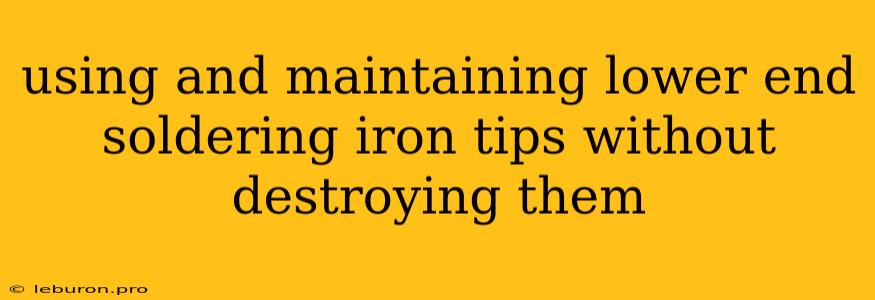Soldering is a fundamental skill for anyone involved in electronics, whether it's a hobbyist or a professional. A soldering iron is your primary tool, and its tip is the crucial element that transfers heat to your work. While high-end soldering iron tips are designed for durability and long-lasting performance, lower-end tips often present challenges in terms of longevity. However, with proper care and maintenance, you can extend the lifespan of your lower-end soldering iron tips and maintain their effectiveness for your soldering needs. This article will delve into the key strategies for using and maintaining these tips without succumbing to premature wear and tear.
Understanding the Challenges of Lower-End Tips
Lower-end soldering iron tips are typically made from cheaper materials and often lack the advanced coatings or heat-resistant alloys found in their premium counterparts. This translates to a higher susceptibility to oxidation, corrosion, and tip damage. Additionally, their construction may not be as robust, leading to warping, cracking, or even complete detachment from the iron.
1. Using the Right Tip for the Job
A fundamental principle of soldering is to match the tip size and shape to the specific task. Using the wrong tip can lead to uneven heat distribution, overheating sensitive components, and ultimately damaging both the tip and your project.
- Tip Size: Choosing the appropriate tip size is critical. For delicate components, smaller tips are preferred, while larger tips are better suited for soldering thicker wires or larger components.
- Tip Shape: The shape of the tip also matters. A chisel tip, for example, is excellent for soldering surface-mount components, while a pointed tip is more suitable for general soldering tasks.
- Tip Material: The material of the tip will also affect its performance. Copper tips are more affordable but tend to oxidize quickly. Iron-plated tips offer better heat transfer and resistance to oxidation.
2. Maintaining Consistent Tip Temperature
One of the most common causes of tip damage is using an excessively high temperature. While a hot tip may seem like it gets the job done faster, it can lead to overheating the solder joint and damaging surrounding components. It can also cause the tip to oxidize and become less effective.
- Temperature Control: Always use the lowest temperature setting that effectively melts the solder.
- Tip Cleaning: Regularly clean the tip with a damp sponge or a dedicated tip cleaner. This removes accumulated solder, oxidation, and flux residues, ensuring consistent heat transfer.
3. Proper Tip Tinning
Tinning a tip involves applying a thin layer of solder to the tip's surface. This process helps prevent oxidation and improves heat transfer.
- Tinning Process: Heat the tip to the desired soldering temperature, apply a small amount of solder to the tip, and use a damp sponge to spread the solder evenly.
- Tinning Frequency: Regularly tin your tip, especially when switching between soldering projects or after a break.
4. Avoid Excessive Force and Scraping
Applying excessive pressure or scraping the tip against the work surface can damage the tip and lead to premature wear.
- Gentle Application: Use a light touch when soldering.
- Proper Soldering Technique: Hold the soldering iron at a slight angle to the joint, allowing the heat to transfer evenly.
5. Store Tips Properly
Proper storage helps preserve the life of your soldering iron tips.
- Tip Protection: Always store tips in a cool, dry place, ideally in a tip holder or container.
- Tip Storage: Avoid storing tips in a cluttered area or with corrosive materials.
6. Troubleshooting Common Issues
Here are some common issues you might encounter and how to resolve them:
- Tip Oxidation: If your tip is covered in a black or gray oxide layer, use a damp sponge or a tip cleaner to remove it.
- Tip Warping or Damage: If your tip is warped or damaged, you may need to replace it.
- Tip Not Heating Properly: Check your soldering iron's heating element, ensure proper power supply, and make sure the tip is securely attached.
Conclusion
Using and maintaining lower-end soldering iron tips is a balancing act between cost-effectiveness and longevity. By understanding the challenges they present, implementing proper techniques, and adopting a maintenance-focused approach, you can extend the lifespan of these tips and achieve satisfactory soldering results. Remember, investing a little time and care can go a long way in maximizing the performance and durability of your soldering iron tips, even those at the lower end of the price spectrum.
